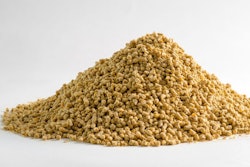
In India, high corn prices are driving market forces toward exports, but the nation’s poultry and feed industries want the grain to remain in the country as a feed ingredient.
The government of India is reported to be considering imposing a ban on exports of home-grown corn, according to Economic Times. However, industry insiders think the government is unlikely to impose such a ban. This is based mainly on the fact that corn is not classed as an essential commodity in India.
Nevertheless, the source reports, the Commerce Ministry has received a request from the Ministry of Food Processing Industry to constrain the outgoing trade. Starch manufacturers say the price of this key raw material has been rising as a result of limited market availability.
In the past, India has exported some corn. Generally, Indian-sourced material is higher in price than that from Argentina or Brazil. However, India has exported relatively small quantities, and to other South Asian and Southeast Asian states, such as Bangladesh.
With South American corn soon becoming available in quantity on the global market, the “export window” for Indian grain is expected to be short.
However, market conditions would support Indian trade for a limited period of time. At 21.3 million metric tons (mmt), the kharif (“monsoon”) corn crop in India is only slightly below last season’s 21.8 mmt, and the current rabi season (“winter”) crop looks set to be much higher. As a result, no shortage of corn is forecast in India, despite strong demand from the feed industry and traders.
The source reports local corn is trading in India at INR22,250 (US$268.30) per metric ton.
If exports are not limited by the government, prices are forecast to rise to INR23,000 in the short term, and possibly longer term to INR25,000, according to Economic Times.
Poultry sector calls for corn export ban
India’s poultry industry is among those sectors calling for a ban, reported Reuters this week.
According to the chair of the feed manufacturers’ association, corn supplies in the country are limited and, as a result, prices are high. These factors he attributed to exports and to damaging monsoon rains.
In the eastern state of Bihar, corn prices are already INR25,000 per metric ton, he stated. He added that the poultry industry is no longer able to pass on higher costs for poultry meat and eggs to consumers.
Over the course of 2019, India exported 1.9 mmt of corn. This rose to 3.6 mmt last year, and had already amounted to 2.4 mmt for the first nine months of 2022.
Forecasts for India’s corn market
Latest forecasts from the U.S. Department of Agriculture (USDA) Foreign Agricultural Service (FAS) put Indian corn production for the marketing year starting in November 2022 at 32 mmt. This is less than the figure of 33.6 mmt for the year just ended, but higher than 31.6 mmt for the previous 12 months.
FAS expects India’s corn imports to amount to 50,000 metric tons (mt), and exports at 2.4 mmt for the 2022-23 season. Use by the feed sector is forecast at 18.5 mmt — 500,000 mt more than in the previous year.
Bangladesh increases corn production
Driven by rising prices and improved profitability, growers in this South Asian nation have expanded the area planted with corn.
According to The Daily Star recently, output was forecast by the United Nations’ Food and Agriculture Organization (FAO) to reach 4.8 mmt in 2022 — an increase of 2% year-on-year.
Driven by rising prices, domestic corn production is expected to expand, according to the Maize Association of Bangladesh. The planting season ends this month.
The main ingredient of feeds for fish, poultry and other livestock, local prices were up 25% year-on-year at BDT30,000 (US$291) per metric ton at their peak this year. Wholesale and retail prices were reported to be at their highest levels since 2016.
Bangladesh’s annual corn requirements — for feed, human consumption and starch manufacture — are 7-7.5 mmt, the source reports. Most of this quantity goes into poultry feed, where it accounts for 50-60% of the feed volume. Imports to cover the country’s corn demand cost Bangladesh US$660 million, the source reports.








